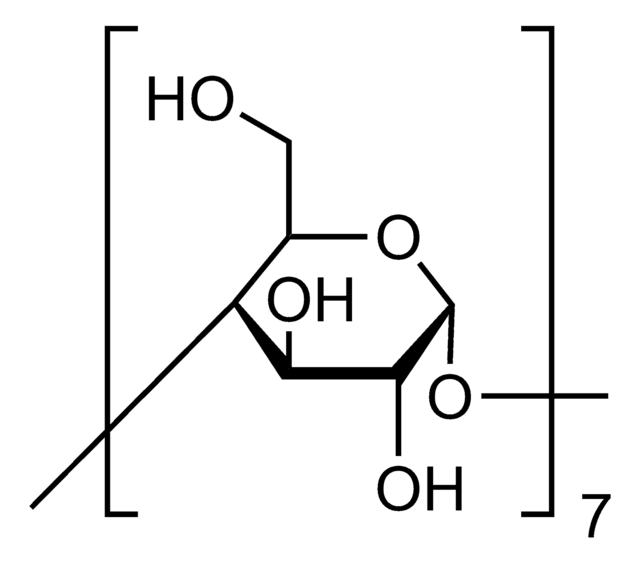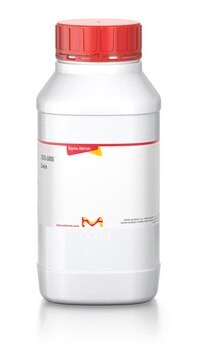24122
Alcool benzylique
puriss., meets analytical specification of Ph. Eur., BP, NF, 99-100.5% (GC)
Synonyme(s) :
Benzèneméthanol
About This Item
Produits recommandés
Densité de vapeur
3.7 (vs air)
Niveau de qualité
Pression de vapeur
13.3 mmHg ( 100 °C)
3.75 mmHg ( 77 °C)
Description
peroxide value <= 5
Qualité
puriss.
meets analytical specification of Ph. Eur., BP, NF
Pureté
99-100.5% (GC)
Forme
liquid
Température d'inflammation spontanée
817 °F
Limite d'explosivité
0.34-6.3 %
Technique(s)
IR spectroscopy: suitable
Impuretés
related substances, in accordance
residual solvents, complies
≤0.02% free acid (as C6H5COOH)
≤0.02% sum peaks before benzyl alcohol (GC)
≤0.05% benzaldehyde (GC)
≤0.05% non-volatile matter
≤0.1% water (Karl Fischer)
≤0.10% cyclohexylmethanol (GC)
≤0.2% related subst. (GC)
≤0.2% sum peaks after benzyl alcohol (GC)
Résidus de calcination
≤0.005% (as SO4)
Indice de réfraction
n20/D 1.539 (lit.)
n20/D 1.539-1.541
Point d'ébullition
203-205 °C (lit.)
Pf
−16-−13 °C (lit.)
Densité
1.045 g/mL at 25 °C (lit.)
Adéquation
complies for identity (IR)
in accordance for appearance of solution
Chaîne SMILES
OCc1ccccc1
InChI
1S/C7H8O/c8-6-7-4-2-1-3-5-7/h1-5,8H,6H2
Clé InChI
WVDDGKGOMKODPV-UHFFFAOYSA-N
Vous recherchez des produits similaires ? Visite Guide de comparaison des produits
Catégories apparentées
Description générale
Application
- Etherification of glycerol.
- Preparation of benzaldehyde by solvent free oxidation using supported undecamolybdophosphate catalyst.
- Synthesis of N-(phenylmethylene)benzeneamine by the reaction with nitrobenzene in presence of rhodium-catalyst.
Conditionnement
Mention d'avertissement
Warning
Mentions de danger
Conseils de prudence
Classification des risques
Acute Tox. 4 Inhalation - Acute Tox. 4 Oral - Eye Irrit. 2
Code de la classe de stockage
10 - Combustible liquids
Classe de danger pour l'eau (WGK)
WGK 1
Point d'éclair (°F)
213.8 °F - DIN 51758
Point d'éclair (°C)
101 °C - DIN 51758
Certificats d'analyse (COA)
Recherchez un Certificats d'analyse (COA) en saisissant le numéro de lot du produit. Les numéros de lot figurent sur l'étiquette du produit après les mots "Lot" ou "Batch".
Déjà en possession de ce produit ?
Retrouvez la documentation relative aux produits que vous avez récemment achetés dans la Bibliothèque de documents.
Les clients ont également consulté
Notre équipe de scientifiques dispose d'une expérience dans tous les secteurs de la recherche, notamment en sciences de la vie, science des matériaux, synthèse chimique, chromatographie, analyse et dans de nombreux autres domaines..
Contacter notre Service technique






